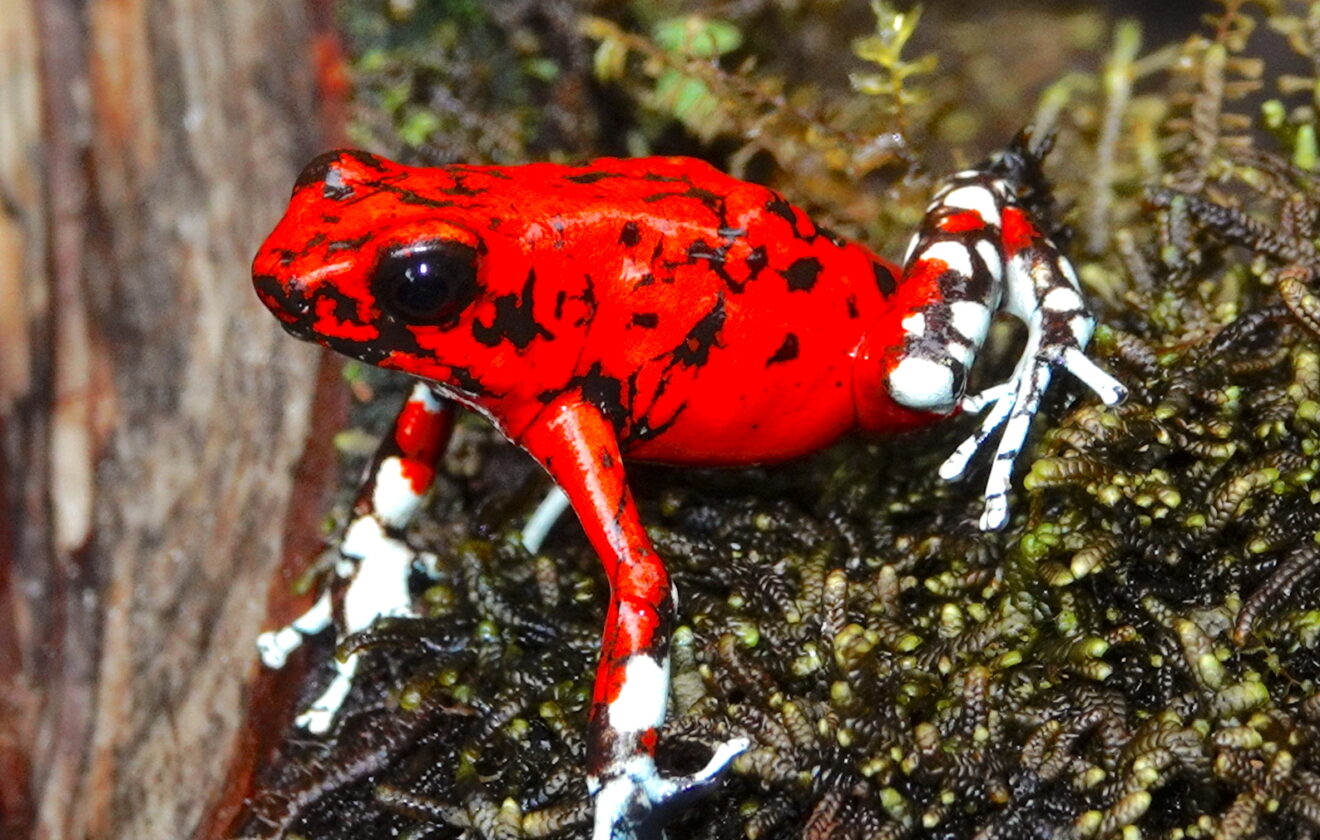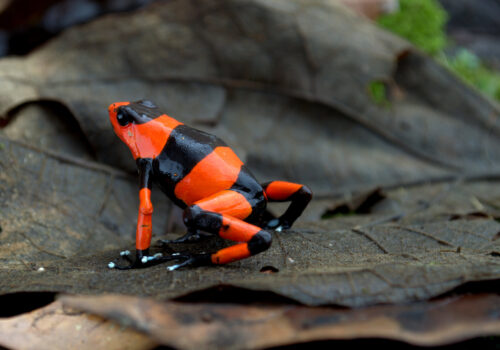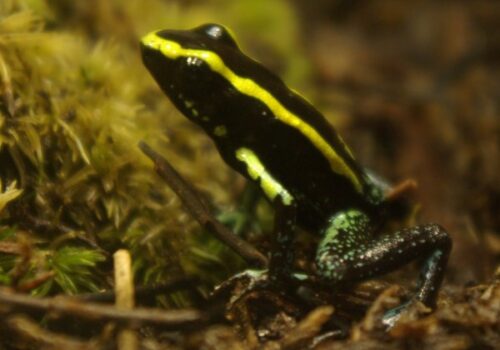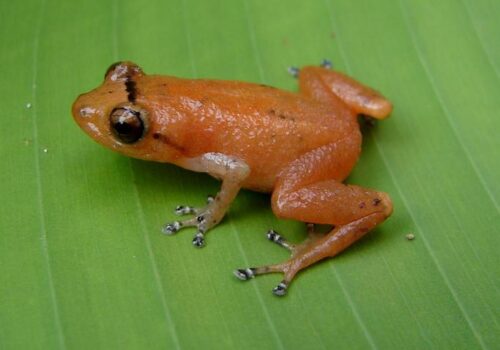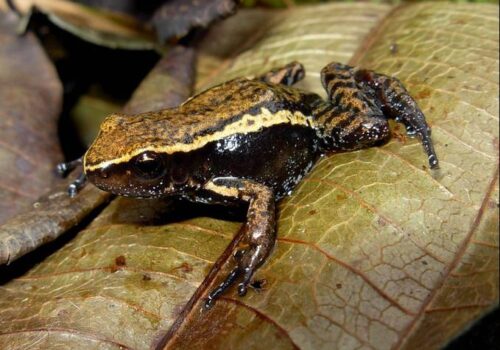- Oophaga sylvatica: The Enchanting Jewel of Ecuador's Rainforests
- Taxonomy and Classification of Oophaga sylvatica
- Natural Habitat: The Rainforest Realm of Oophaga sylvatica
- Physical Characteristics: A Palette of Survival
- Behavior and Reproduction: Parenting in Miniature
- The Frog’s Crucial Ecological Role
- Threats and Conservation Efforts
- Cultural and Scientific Significance
- Conclusion: Preserving a Vibrant Marvel of Nature
Oophaga sylvatica: The Enchanting Jewel of Ecuador’s Rainforests#
Deep within the lushest rainforests of northwestern Ecuador, amid layers of emerald foliage and gentle mist, dwells a brilliant jewel painted by nature’s own hand—the Diablito poison frog, scientifically known as Oophaga sylvatica. Small enough to perch elegantly atop a jungle leaf yet bold enough to carry a potent natural toxin, this species exemplifies both the beauty and danger concealed within Earth’s tropical treasures.
The vibrant hues of Oophaga sylvatica aren’t merely stunning visual marvels—they are vivid warnings, evolutionary masterpieces that tell potential predators clearly, “Danger, beware!” And yet, beyond this toxic defense lies an intriguing world of complex social behaviors, sophisticated parental care, and a fragile relationship with the rapidly changing rainforest ecosystem. Step into the verdant heartland of Ecuador’s Chocó bioregion, and let’s explore the extraordinary life of a tiny amphibian whose presence speaks volumes about biodiversity, ecological balance, and the need for urgent conservation action.
Taxonomy and Classification of Oophaga sylvatica#
Oophaga sylvatica, commonly called the Diablito frog or Little Devil Frog, falls under the Amphibia class, within the order Anura—the tailless amphibians commonly referred to as frogs and toads. This brightly-colored creature belongs to the family Dendrobatidae, a conspicuous group of frogs known globally for their potent defensive toxins, smaller size, and vividly striking colorations. The term “Oophaga,” translating roughly to “egg eater,” references the unique parental behavior exhibited by members of this genus, highlighting their fascinating reproductive strategies and close familial bonds.
Within the genus Oophaga, this particular species is closely associated with other poison dart frogs famed for their intense skin toxins, advanced parental care, and iconic coloration patterns. Among these cousins, the Diablito frog remains distinguished by its color variability, its limited distribution primarily within Ecuador’s humid coastal forests, and its critical significance as a flagship species for regional conservation efforts.
Natural Habitat: The Rainforest Realm of Oophaga sylvatica#
To truly comprehend the splendor and struggles of Oophaga sylvatica, one must journey into the dense, humid tropical rainforests of northwestern Ecuador—more specifically, the biodiversity-rich Chocó ecoregion. Misty, verdant, and hauntingly beautiful, these forests burst with life, from immense towering ceiba trees to delicate orchids clinging gracefully to twisted branches, all set amid the gentle murmur of hidden streams and rainfall dripping rhythmically.
The Diablito frog makes its home in lowland and foothill forests, thriving best within undisturbed, primary habitats. Beneath a dense canopy, sunlight slices through in thin golden streams, illuminating pools of water collected inside bromeliad leaves—miniature worlds crucial for the frog’s reproduction. Here on humid forest floors, leaf litter carpets shelter countless life forms. It is within this rich and complex ecosystem that our tiny frog finds shelter, lays its precious eggs, and hunts small yet nutritious prey, such as ants, mites, and other arthropods.
Microhabitat Preferences#
Each niche within the rainforest serves a critical role in the Diablito frog’s survival. Bromeliads, epiphytes, vines, fallen logs, and moist leaf litter create intricate microsystems where frogs can safely breed, forage, and escape predators. Females strategically choose bromeliads and other small water-filled epiphytes to deposit their fertilized eggs, demonstrating a remarkable behavior of site selection that ensures the next generation’s optimal chance for survival.
Physical Characteristics: A Palette of Survival#
At barely 3 centimeters in length, Oophaga sylvatica may be small enough to disappear in your palm, but its captivating colors loudly demand attention. Hues range dramatically from vivid reds, fiery oranges, brilliant yellows, to deep blues, blacks, and greens. Markings vary considerably—in fact, few frog species exhibit so much color and pattern variability. Such diversity isn’t merely aesthetic; rather, it signals critical evolutionary significance, warning predators of the potent alkaloid toxins concentrated in the frog’s skin.
The Diablito frog has smooth, damp skin that aids in respiration and toxin secretion—a clever evolutionary adaptation to the humid microclimates of its surroundings. Powerful hind limbs, though tiny, enable precise and deft movements among the cluttered rainforest floor, facilitating swift escapes when necessary. Slight pads on tiny toes even allow for climbing bromeliads, low branches, and vertical surfaces, ensuring these frogs can effectively utilize every corner of their complex environment.
Behavior and Reproduction: Parenting in Miniature#
Equally enthralling as their impressive coloration is the sophisticated social and reproductive habits of Oophaga sylvatica. Unlike many frogs and amphibians who lay eggs en masse and leave them unattended, Diablito frogs exhibit meticulous parental investment with incredible precision.
Courtship and Breeding Rituals#
The journey to parenthood begins with the male Diablito calling melodically from hidden perches amidst the vegetation. These distinctive soft trill-like calls signal their fitness as mates to nearby females and create the gentle acoustic landscape of the rainforest understory. Upon selecting a suitable mate, the female carefully lays a small clutch of fertile eggs within damp leaf litter, bromeliad cups, or crevice-bound micro ponds formed by tangled vegetation—a protected nursery calculated for survival.
Remarkable Parental Care#
After hatching, the male frog guards the eggs diligently. But the truly extraordinary behavior comes from the female who transports newly hatched tadpoles carefully, one at a time, onto her back, diligently carrying them upward into the safety of individual bromeliads or water-gathering plants. Each tadpole is deliberately placed in isolated nurseries—a cautious strategy ensuring prevention of competition or cannibalism among siblings.
Over subsequent weeks, in a truly spectacular display of maternal care, the female returns to each individual tadpole, regularly supplying them with nutrient-rich unfertilized eggs—a critical dietary supplement essential to their development. It is this unique, meticulous nourishment method that earns their genus name “Oophaga,” meaning egg eater.
The Frog’s Crucial Ecological Role#
Within the intricate web of the rainforest, every creature holds vital importance, and Oophaga sylvatica is no exception. As predator and prey, these diablito frogs significantly influence their ecosystems, notably regulating populations of small arthropods like ants and mites. Additionally, their presence provides prey to specialized predators—species uniquely adapted to their toxicity, like certain snakes—fostering the evolutionary dance of predator avoidance and adaptation.
Moreover, these vibrantly hued frogs act as bioindicators, crucial environmental sentries signaling the overall health of local ecosystems. Vigorous populations hint at a pristine, balanced rainforest, while declining numbers highlight imbalances such as pollution, habitat loss, climate fluctuations, or invasive species threats.
Threats and Conservation Efforts#
Sadly, despite their crucial ecological importance and striking adaptations, Oophaga sylvatica faces significant existential threats. Severe habitat loss due to deforestation, logging, expanding agriculture, illegal mining, and human settlements continually diminish the precious forests these frogs depend upon. Additionally, Chytrid fungus and climate change alterations threaten these delicate and survival-sensitive amphibians. Recognizing their fragility, the International Union for Conservation of Nature (IUCN) lists Oophaga sylvatica as Near Threatened, reinforcing the urgent need for decisive conservation interventions.
Cultural and Scientific Significance#
Throughout human history, poison dart frogs and their cousins, including the Diablito frogs, hold deep cultural resonance within indigenous communities. Local traditions long respected their beauty and power, some even utilizing their potent toxins for traditional hunting arrows. Scientifically, Oophaga sylvatica offers potential insights into pharmaceutical discoveries—its unique toxins could hold valuable medically applicable properties still unexplored.
Conclusion: Preserving a Vibrant Marvel of Nature#
In the mesmerizing rainforested world of northwestern Ecuador, Oophaga sylvatica symbolizes both nature’s creative wonder and its inherent vulnerability. Protecting their disappearing forests ensures the preservation of countless other species, sustaining biodiversity and ecological wellness vital to our whole planet. Embracing the delicate balance represented by this tiny and colorful amphibian compels each of us, nature enthusiasts, students, and conservationists alike, towards devoted conservation actions and sustainable coexistence with nature’s most striking creations.








